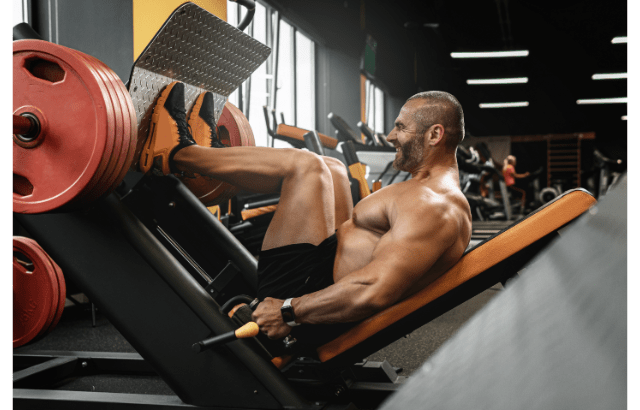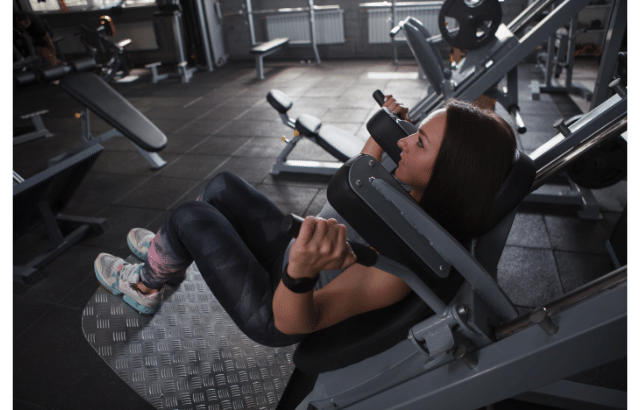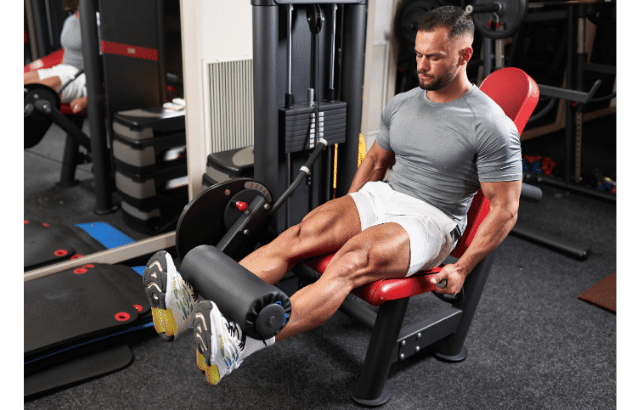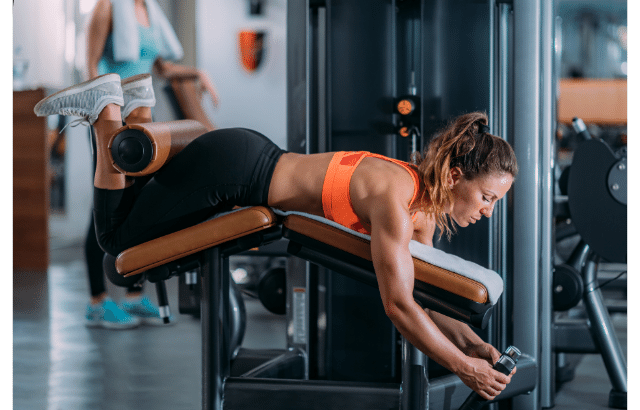Strong legs not only look good but also provide the foundations or living an active lifestyle whether that be playing competitive sports, doing a 5km run or playing with the kids in the garden.
The squat is the most popular exercise for building up the legs and is hugely effective however there are many other options for spicing up a leg workout and delivering excellent results in the process.
In this post, we’ll take a look at the 5 best leg machines in the gym , how to use them and the benefits of each so you can re-ignite your leg training and get outstanding results in the process!
1. Leg Press Machine – Power & Strength
The leg press machine is the most popular machine, and for good reason. This machine allows you to target multiple muscle groups in your legs, including your quads, hamstrings, and glutes. It’s also a great option for anyone who has mobility restrictions that make squatting difficult.
Absurd Fitness Warning – This machine is also most open to abuse by gym goers who load the machine with 10 x 20kg plates and don’t bother returning the plates once finished. Once you become a powerhouse with bulging quads, do not become one of these people!
How to Use The Leg Press
- Load the Weight – Start light so you can get used to the movement and can feel the leg muscles working.
- Get in Position Sit on the machine, put your fee on the plate about shoulder width apart and knees bent at 90 degrees
- Begin the movement: Push against the footplate with your heels, extending your legs and then release the safety handles which will allow you to complete a full range of motion.

4. Range of motion: Lower the weight until your knees are at approximately a 90-degree angle or slightly lower, without allowing your lower back to lift off the backrest. Do not fall into the trap of putting too much weight on the machine so that the weight looks impressive but you can barely move the plate!
5. Pushing phase: Exhale and push the weight back up by extending your legs. Keep your movements smooth and avoid bouncing the weight at the bottom position.
6. Proper form: As you lower the weight, focus on controlling the movement and maintaining a slow and controlled descent. Avoid locking out your knees or rounding your lower back.
2. Hack Squat Machine
The hack squat machine is a versatile piece of equipment that primarily targets your quadriceps, hamstrings, and glutes. It provides a different variation of the squat exercise with additional support and stability.
The hack squat machine is designed to simulate a squat movement. It typically consists of a large footplate, a backrest, and handles or handrails for stability. By using the machine, you can perform squats with a more upright torso position, which may be beneficial for individuals with lower back issues or those who want to emphasize their quadriceps.
How to use the Hack Squat
- Adjust the machine: The footplate should be positioned so that your feet are shoulder-width apart and centered on the plate. The backrest should support your lower back comfortably.
- Load the weight: Add the desired weight plates to the machine, starting with a lighter weight if you’re new to the exercise.
- Position yourself: Step onto the footplate with your feet shoulder-width apart. Your toes can be slightly pointed outward, or you can experiment with different foot positions to target specific muscles. Stand tall and align your shoulders with the machine’s handles or handrails.

4. Grip and stabilize: Grasp the handles or handrails for stability. This will help you maintain balance and control throughout.
5. Initiating the movement: Begin by bending your knees and lowering your body into a squat position. Keep your back straight, chest up, and core engaged. Avoid leaning too far forward or rounding your lower back.
6. Range of motion: Lower yourself until your thighs are parallel to the footplate or slightly below. This allows for a full range of motion and better activation of the targeted muscles.
7. Ascending phase: Exhale and push through your heels, extending your knees and driving your body back up into the starting position. Keep the movement controlled and avoid locking out your knees at the top.
8. Repetitions and sets: Aim for 8-12 repetitions per set, depending on your fitness level and goals. Perform 2-4 sets with appropriate rest intervals in between.
3. Leg Extension – Isolate those Quads!
The leg extension is a popular machine found in pretty much every gym, this one is great for beginners as it is such a simple machine to use.
Leg extensions are an excellent movement for isolating the quadriceps (thigh), the body is well supported so that the quads do all the work and you should be able to feel the burn pretty quickly with this exercise.
How to Use the Leg Extension
- Adjust the seat: Start by adjusting the seat height so that your knees align with the machine’s pivot point. This ensures that the resistance is evenly distributed throughout the exercise.
- Adjust the backrest: Set the backrest in a comfortable position, allowing your upper body to be supported without excessive strain or discomfort.
- Position your legs: Sit on the machine with your back pressed firmly against the backrest. Place your feet under the leg pad, with the pad resting just above your ankles and your knees aligned with the machine’s pivot point

4. Adjust the leg pad: Check that the leg pad is adjusted to fit your leg length properly. The pad should rest comfortably against your shins, just above your feet. There is usually a handle to the right of the pad that allows you to change the setting.
5. Grip the handles: Some leg extension machines have handles or sidebars for added stability. If available, grip these handles to maintain a steady position throughout the exercise.
6. Execute the movement: Start by fully extending your legs in a controlled manner, pushing against the resistance provided by the machine. Keep your abdominal muscles engaged and maintain a neutral spine position throughout the exercise. Pause briefly at the top of the movement to fully contract your quadriceps and feel the burn!!
7. Lower the weight: Slowly lower the weight by bending your knees, returning to the starting position. Avoid letting the weight stack crash or slam down, as this can place undue stress on your knees and suggest the weight is too heavy to get a decent contraction! Poor form = Poor results!
4. Seated Leg Curl Machine – Hamstrings!
This one sounds a bit like a repeat of the leg extension based on the description above but this machine places you in an entirely different position to target the hamstrings.
Hamstrings are often overlooked in training programs but putting in some time on this machine will help to develop nicely balanced muscular legs and stronger hamstrings will improve performance in some of the big lifting movements like squat and deadlift.
How to Use the Seated Leg Curl Machine
- Set Up – Lie face down on the bench and adjust the settings so that the leg pad rests just above your ankles
- Grip the support handles which are usually positioned just underneath the bottom of the bench
- Flex your knees and bring your ankles towards your bottom whilst keeping your body tight to the bench.
- Slowly lower you ankles back to the starting position to complete the rep.

If hamstrings are an area where you would like to specifically focus , have a read of our article on the The 5 Best hamstring Exercises you should start doing now!
5. Smith Machine
The smith machine provides an alternative to a standard squat rack and is comprised of a steel frame with a horizontal bar attached to two fixed vertical rails. The bar can be loaded with free weights and locked into position at various different heights.
The bar can only move along a fixed vertical path which provides stability and support when performing movements like the squat or lunge. This is particularly beneficial for anyone that struggles with balance or has a weak core.
The smith machine is not without critics though, many lifters prefer the flexibility and freedom of movement that training with a barbell allows as well as the greater demands placed on the body from having to stabilise and balance the bar.
The smith machine can be used to squat, lunge and perform calf raises.
How to Use the Smith Machine
- Set the bar to the desired height
- Position the safety catches in place to ensure the bar can be dropped if required
- Load the bar with weights
- Execute

Advantages of Using Machines
Machines can be used alongside free weights to provide variety to your workout and offer a many benefits to ensure you maximise your gains in the gym!
Good for Beginners
Machines often provide support for the athlete and control the range of motion to help athletes to become familiar with the movements and to develop in a controlled manner. This helps beginners to gain confidence as well as build up a solid base strength
Isolation & Targeting
Machines are very effective for isolating specific leg muscles to strengthen weak points, correct an imbalance or simply build greater aesthetics.
Reduce Strain on Joints
Machines can help minimize stress on joints as the guided movement and fixed range of motion in machines can be gentler on the joints compared to free weights which require more stability and control. Trust me, this helps as you get older!
Monitoring Progress
A lot of machines have built in weight stacks or resistance levels making it simple to keep progressing and overloading the muscles in a controlled manner.
Workout Ideas
There is no one size that fits all so workout content should be aligned to your own individual goals.
In the author’s view, machines are best utilised to supplement free weights exercises.
If squats form the cornerstone of your leg workout why not incorporate leg extensions and leg curls to really build up those quads and hamstrings which will assist your progress in the squat.
We would suggest 4 sets of 8-12 reps is sufficient for each machine exercise you add to your routine and to slowly increase the weight once 12 reps can be completed comfortably at
Summary
We have provided an overview of the best leg machines in the gym for you to consider adding to your workout regime
It is clear that machines can be used to help maximise results in the gym in combination with free weights. The pros and cons really are specific to each individual’s circumstances, strengths and weaknesses.
We hope we have provided some information here that helps you along your training journey!
0 Comments